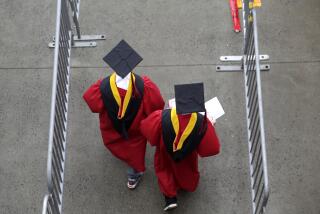Have Colleges Strayed From Their Mission? : Team Grades Undergraduate Teaching
- Share via
PRINCETON, N.J. — In a pink stucco mansion near the Princeton University football stadium, Ernest L. Boyer has been thinking about whether America’s 3,200 colleges have strayed from their mission: teaching undergraduates.
“There’s a series of mismatches between expectations and the reality,” when a young person starts teaching at a college, he said. “A professor may say, ‘I’m a Ph.D. and I can tell you all there is to know about “King Lear” and I’m dealing with a classroom of kids who don’t know what England is, let alone Shakespeare.’ ”
Boyer, the president of the Carnegie Foundation for the Advancement of Teaching, dispatched observers to 30 campuses across the country. Their findings sit on his desk in a black binder, thicker than the Manhattan telephone directory.
In a few months, a book, “College: The Undergraduate Experience in America,” will appear. Two years ago, Boyer’s report on high schools played a big role in the debate, still under way, about how to restore value to a high school diploma.
Boyer, who was president of the sprawling State University of New York and then U.S. commissioner of education in the Carter Administration, defends the openness of America’s colleges, saying: “I think we’ve gained powerfully more from the diversity and richness of the American system than we’ve lost from the sloppiness on the edges.”
He does not expect the new Carnegie report to generate the same intensity of debate that attended the reports on reforming American high schools because the public “doesn’t feel the same sense of ownership” for colleges.
The colleges’ problems, he added, are not as deep-seated. But a Carnegie-commissioned survey of 5,000 professors found that two-thirds said they spent too much time teaching what students should have learned in high school, and nearly 40% are thinking of leaving the profession within five years.
And students feel forgotten in a system in which professors’ rewards are based not on their gift for teaching but on their research.
“The undergraduate college has been increasingly neglected and ambiguous about its mission,” he said. “It’s tended to be overshadowed by the research capacity and, increasingly, by professionalism and careerism. . . . It has lost its integrity in many campuses,” he said.
Colleges underwent a tremendous expansion in the three decades after World War II to accommodate first the veterans and then their offspring. Community colleges sprang up in the 1960s and many universities relaxed their admission standards. Now, more than 12 million students are pursuing degrees, and half of all high school graduates attend post-secondary institutions.
“I don’t think we can ever measure the vitality that comes by having open systems that give hope to lots of people and let them say to themselves, ‘Yes, I have a crack at it.’
“When you start bottling up and capping and routing, you not only deny individual possibilities, but you really build enormous pockets of frustrations in the culture.”
More to Read
Sign up for Essential California
The most important California stories and recommendations in your inbox every morning.
You may occasionally receive promotional content from the Los Angeles Times.










